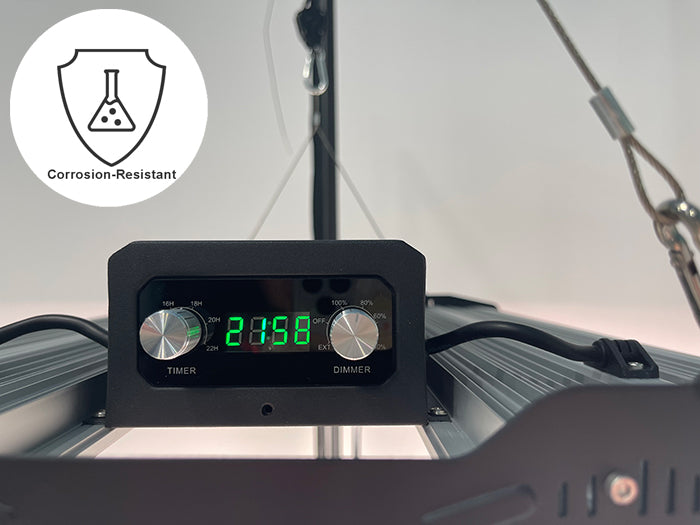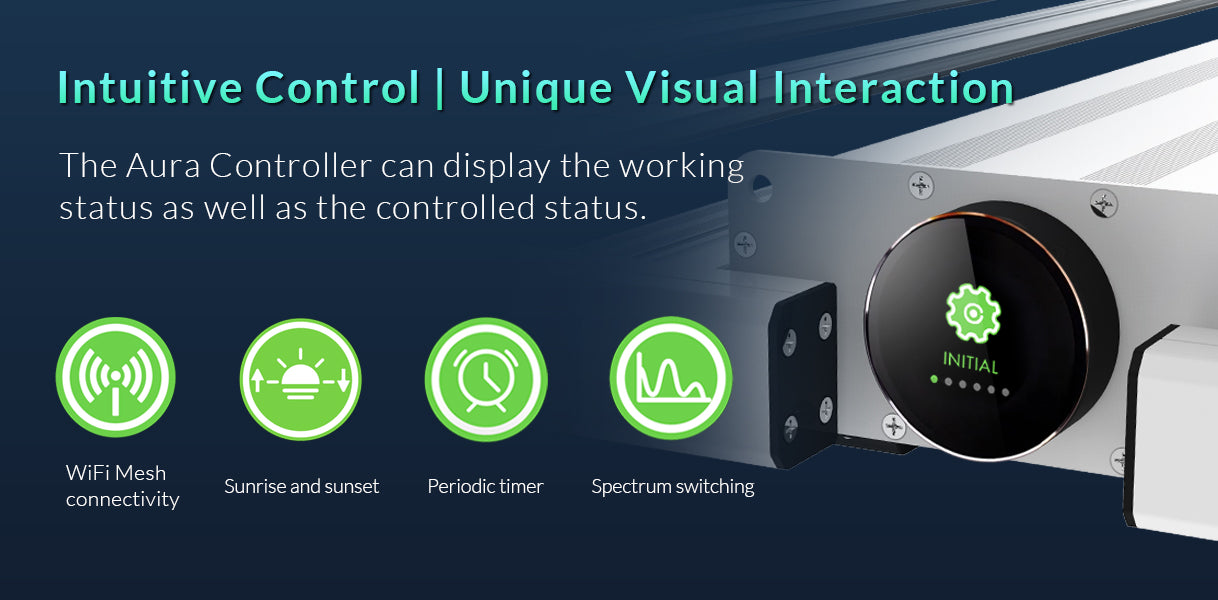
How To Maintain LED Grow Lights
Introduction
One of the biggest concerns of every indoor grower is how to maintain LED grow lights. There is no doubt that LEDs have become almost indispensable in growing plants in today's terms. However, to deny the place of regular maintenance is to reject having to get your money's worth from purchasing the LED grow light itself.
This article shows you why and how to maintain greenhouse lights and your favorite LED grow lights without stress.
- Part 1: Conditions for Indoor and Green House Growing
- Part 2: How Do I Clean LED Grow Lights?
- Part 3: How Often Do LED Grow Lights Need to Be Replaced?
- Part 4: Conclusion
- Part 5: FAQs
Conditions for Indoor and Green House Growing
Several factors must be put in place to ensure that your cannabis plant performs optimally. These conditions must be met whether you are growing plants indoors or using the greenhouse method. Some of these factors include temperature and humidity, sunlight, soil moisture, and carbon dioxide.
Temperature
Temperature is arguably the most essential requirement for plant growth. Knowing the uniqueness of plants in terms of temperature goes a long way to determining successful growing. While there are plants that need high temperatures to support growth, there are others that don’t need as much. So, knowing what works best for your plant is paramount.
The indoor and greenhouse temperatures need to be maintained regardless of the fluctuations in the external temperature. The endpoint of plants' photosynthesis leads to heat generation. This could build up if it is not properly managed. So, for plants that do well in high temperatures, it will be best to reduce external temperatures, as the former should suffice. This excessive heat generation could adversely affect plants that do not require much heat to support their growth. This means you should be cautious when managing your indoor growing process and greenhouse growing.
A sophisticated greenhouse monitoring system is set to give off an alarm whenever there is an increased temperature beyond what your plants can handle. This is why one of the best options for growing plants in a greenhouse setting is by using greenhouse lights. They are designed to deliver adequate temperature conditions while they stimulate plant growth.
Humidity
Another crucial factor that determines how best your plants will grow is humidity. Plants usually give off moist, warm oxygen and process carbon dioxide, making the greenhouse and the indoor environment warm and moist over time.
As it is with temperature, plants don’t require the same level of humidity. Molds may begin to grow on some plants when the humidity levels are increased, which could make your plants ‘sick.’
Light
Plants generally need light for photosynthesis, and in regular practice, they will derive light from the sun. The light intensities that plants need also vary from plant to plant. Some plants prefer strong sunlight, while others prefer a lesser intensity. It is almost impossible for growers to regulate sunlight exposure consistently. This is why they need a greenhouse setup. For instance, having the best dimmable LED grow light will give this desired effect.
It is proper to install at least 4 LED grow lights to attain uniform distribution within the greenhouse. The greenhouse system will give off a signal whenever the light intensity levels drop and help you optimize light exposure. However, to secure the possibility for long-term management it is vital to maintain LED grow lights.

There is a slight difference between greenhouse lights and lights for indoor growing, e.g., 4ft full spectrum LED grow lights. The difference is like the material from which the lights are made. For instance, indoor LED grow lights must be corrosion-resistant, which is why MINISUN-2 is a highly recommended option. While greenhouse LEDs should be waterproof, like Slim Power 2. However, ensure to maintain LED grow lights for maximum efficiency.

Soil Moisture
In farm productivity, the moisture of the soil is a primary factor. Providing adequate amounts of water to plants will prevent poor yields. However, the excess water could also destroy plants by causing root diseases and ultimately causing water wastage.
Water is the primary vehicle that delivers nutrients to plants that are not tightly attached to the soil. So, it is essential to have a top-notch water management system to ensure longevity. This is where having a controller in your full spectrum LED grow light could help monitor, control, and maintain adequate soil moisture in your greenhouse.
Carbon Dioxide
Plants also need carbon dioxide for growth. So, growers need to monitor the carbon dioxide levels and supply CO2 whenever its levels drop in the greenhouse. Too low levels of CO2, as well as extremely high levels, are both not beneficial to your plants. Adjusting CO2 levels when inadequacy is detected early will trigger plant growth, yield, and an increased harvest.
An excellent greenhouse monitor comes with the best LED grow lights for 3X3 tents to help you detect drops in CO2 levels.
How Do I Clean LED Grow Lights?

An essential part of maintaining your LED grow lights is cleaning. The best time to clean is after every harvest, as this will ensure that no dirt, stain, junk, or mud is spared. It makes sense to clean regularly as this will ultimately prevent losses in light output.
The first step is to properly read the cleaning instructions for the LEDs and then follow them strictly. Ensure that the lights are unplugged, and let them cool off. Do well to inspect the bulbs for any obvious damage before you start cleaning.
It is advisable to use a soft handkerchief while cleaning the frame of the grow light, then use a dry cloth to remove any moisture. To clean the frame of your grow light, carefully wipe it using a clean handkerchief, and wipe it with a dry cloth. Blow off the dust from the surface of the light board using a fan, for the light board. Then, use a soft cloth to clean off the rest of the dust and keep your LED light shiny and clean.
An essential factor to consider to maintain LED grow lights is the raw material used to make the light in question. Some LED grow lights are waterproof, while others are corrosion-resistant. This means growers should avoid using substances or cleaning materials that could adversely affect the LED materials. For instance, if the LEDs are made of metallic products, don't leave moisture after cleaning. Also, for non-corrosion-resistant materials, be extra careful about the cleaning liquids you may employ.
Generally, the best cleaning method will be one that leaves the LED to grow light and dry and improves efficiency. An ideal cleaning method and agent will allow the Led last its tenure and not complicate issues indoors or in your greenhouse.
Don’t forget to clean all the components of the LED grow lighting system. Crucial components to watch out for include:
- Diodes
- The driver
- Surge Protector
- Frame
Not paying attention to proper maintenance could weaken even the best 3X3 LED grow light.
How Often Do LED Grow Lights Need to Be Replaced?
Let’s establish one thing, “all grow lights cannot be replaced at the same time, no matter the type you have.” Replacement intervals vary widely among different grow light types - so is the rate at which they lose their efficiency over time. Judging all grow lights, in the same way, could cost you much in how much efficiency they each will lose. So, understanding how your light works and its lifecycle could save you lots of stress going forward.
The latest technological advancement for indoor growers is the LED grow light. One of the benefits they confer is efficiency. Any grower who wishes to have a grow light that lasts long should keep LED grow lights as a top choice.
LEDs use little energy while still giving off intense light. Lots of these LEDs give off a full spectrum light and allow growers to switch between blue and red lights.
The quality of the LED grow light components determines the longevity. The longevity of all available LED grow lights varies. However, in the grand scheme of things, LED grow lights last longer than other grow light types.
Replacing LEDs has a cost implication, something that interests all growers. At some point, your LED grow light will have diminished in its efficiency, so you need to be prepared. However, you need not worry about frequent replacement because of its longevity.
So, how often should you replace your LED grow lights?
It greatly depends on the quality of your LED grow light set. The standard time is usually between 5 to 10 years. At least, you have the benefit of using LEDs for a reasonable number of years before any malfunction.
Conclusion
To maintain LED grow lights, you need to pay extra attention to the material type, cleaning, and how it is used in your greenhouse or indoors. Selecting the best grow lights will involve checking the list for adjustability and ease of maintenance. Maintaining your LED grow lights guarantees that you will get high crop yields and healthy plants for about a decade. So, an investment in LEDs is a wise and profitable one. In the conversation of productivity, LEDs trump other grow lights; however, proper maintenance will always guarantee efficiency.
FAQs
How Do I Clean My LED Grow Lights?
You may need a mild detergent, water, and a cloth. Gently clean the lens of the lights, its nook, and crannies till they are clean. Finally, dry using a towel, and check to confirm your light is in good condition.
Can I leave my LED grow lights on at all times?
Don't leave your grow lights on all the time because plants need to have a balance between light and darkness to develop properly. They need sort of a break to get their nutrients towards their extremities.
Do I need to clean LED lights?
Cleaning LED lights help to improve their quality and efficiency. You also need to clean LEDs because the dirt buildup could reduce their longevity.
Do LEDs need to be replaced?
Yes. However, compared to other grow lights, LEDs can stay for up to a decade without needing replacement. However, when issues come up, do not hesitate to replace them.
- Choosing a selection results in a full page refresh.
!

